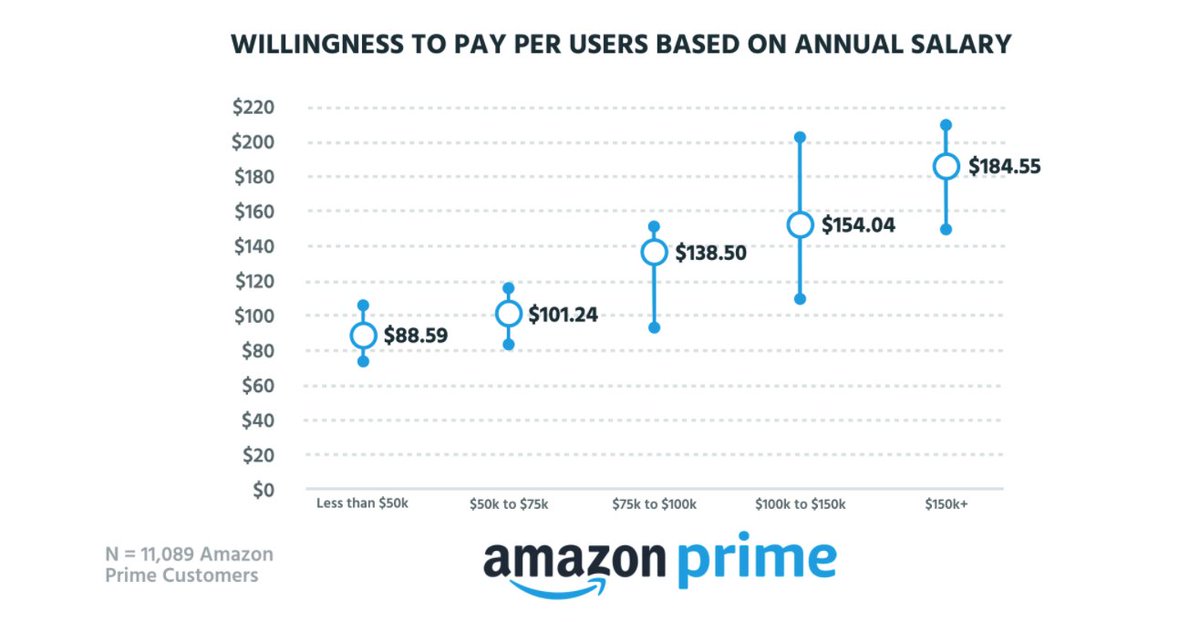A product so good it gets its own day.
Amazon Prime is arguably the most prevalent subscription service in the history of mankind.
Here’s how they got to where they are today and where we think they’re headed https://abs.twimg.com/emoji/v2/... draggable="false" alt="👇" title="Rückhand Zeigefinger nach unten" aria-label="Emoji: Rückhand Zeigefinger nach unten">
https://abs.twimg.com/emoji/v2/... draggable="false" alt="👇" title="Rückhand Zeigefinger nach unten" aria-label="Emoji: Rückhand Zeigefinger nach unten">
Amazon Prime is arguably the most prevalent subscription service in the history of mankind.
Here’s how they got to where they are today and where we think they’re headed
Amazon’s goal is simple: get you to buy something else.
You could argue that that’s the goal of *any* business, but amazon approaches it differently.
Enter: Amazon Prime.
You could argue that that’s the goal of *any* business, but amazon approaches it differently.
Enter: Amazon Prime.
Prime started with a simple perk: free two day shipping.
This got customers in the door and got them to ultimately buy more stuff from Amazon.
So, goal achieved. But! It also did something important for prime’s success in the long run.
This got customers in the door and got them to ultimately buy more stuff from Amazon.
So, goal achieved. But! It also did something important for prime’s success in the long run.
If you’re a prime member, chances are good that you look at Amazon first when you need to buy something.
That’s not an accident.
A key part of Amazon’s strategy was creating customer loyalty to Prime *benefits*
That’s not an accident.
A key part of Amazon’s strategy was creating customer loyalty to Prime *benefits*
More perks = more loyalty: prime video, kindle library, music… and today, a whole day of discounts for members.
Prime& #39;s success in remaining competitive has come at the expense of larger profit margins on the front end, but remember— the goal is to get you to buy more stuff.
Prime& #39;s success in remaining competitive has come at the expense of larger profit margins on the front end, but remember— the goal is to get you to buy more stuff.
By focusing on creating customer loyalty to Prime benefits instead of maximizing profits upfront, Amazon’s customers have a higher price-increase tolerance.
BUT not all member segments view price hikes equally:
BUT not all member segments view price hikes equally:
So an across the board price hike of 50% would likely face hard resistance and loss of confidence, no matter how much groundwork they’ve laid.
But that’s not the only option to increase Amazon’s margins.
But that’s not the only option to increase Amazon’s margins.
Remember their focus on loyalty to prime benefits? This sets them up perfectly for introducing tiered pricing.
Let’s dig into how https://abs.twimg.com/emoji/v2/... draggable="false" alt="👇" title="Rückhand Zeigefinger nach unten" aria-label="Emoji: Rückhand Zeigefinger nach unten">
https://abs.twimg.com/emoji/v2/... draggable="false" alt="👇" title="Rückhand Zeigefinger nach unten" aria-label="Emoji: Rückhand Zeigefinger nach unten">
Let’s dig into how
Streaming is the perfect example of what will make Amazon profitable in the future.
Amazon sets up the future monetization by first using it as a “free” way to get people through the door and hooked on its perks
Amazon sets up the future monetization by first using it as a “free” way to get people through the door and hooked on its perks
Streaming was a *really* good choice: based on data from over 11k Amazon Prime customers, it ranks as one of the the highest-valued features offered:
This is a great lesson in recognizing cues to differentiate customer segments.
It& #39;s obvious that customers would latch onto membership options with concierge-style premium features like discounts, early access, and free same day delivery.
...for an additional fee, of course.
It& #39;s obvious that customers would latch onto membership options with concierge-style premium features like discounts, early access, and free same day delivery.
...for an additional fee, of course.
Enter: Prime Tiers.
When we look at willingness to pay based on annual salary, we see a pretty deep divide:
When we look at willingness to pay based on annual salary, we see a pretty deep divide:
Consumers who make more than $75k a year would go up to $200 a year for Prime, for concierge features and access.
This divide shows a strong argument for raising prices and a strong case for creating premium options, but they shouldn& #39;t ditch a core prime tier either.
This divide shows a strong argument for raising prices and a strong case for creating premium options, but they shouldn& #39;t ditch a core prime tier either.
Amazon& #39;s quest to be everything, including Walmart, they need to keep in mind the spending point of lower-income, entry-level members.
Amazon should always have an affordable Prime package available to retain those customers.
Amazon should always have an affordable Prime package available to retain those customers.
If you& #39;ve gotten all the way to the end of this thread, drop your favorite prime day purchase in the replies  https://abs.twimg.com/emoji/v2/... draggable="false" alt="😉" title="Zwinkerndes Gesicht" aria-label="Emoji: Zwinkerndes Gesicht">
https://abs.twimg.com/emoji/v2/... draggable="false" alt="😉" title="Zwinkerndes Gesicht" aria-label="Emoji: Zwinkerndes Gesicht">
For a deeper dive on all the data behind this thread, check out the full episode of Pricing Page Teardown here: https://www.priceintelligently.com/blog/amazon-prime-pricing">https://www.priceintelligently.com/blog/amaz...
For a deeper dive on all the data behind this thread, check out the full episode of Pricing Page Teardown here: https://www.priceintelligently.com/blog/amazon-prime-pricing">https://www.priceintelligently.com/blog/amaz...

 Read on Twitter
Read on Twitter




